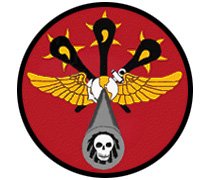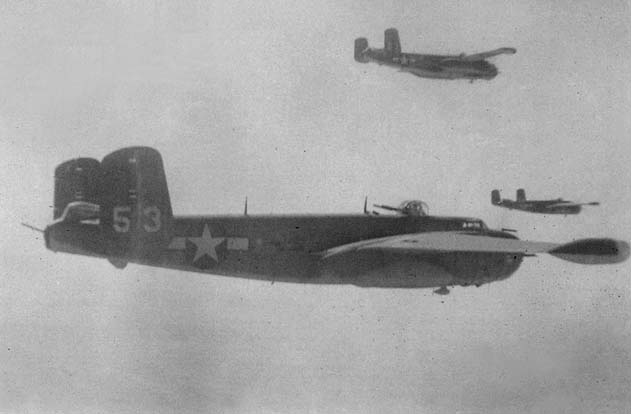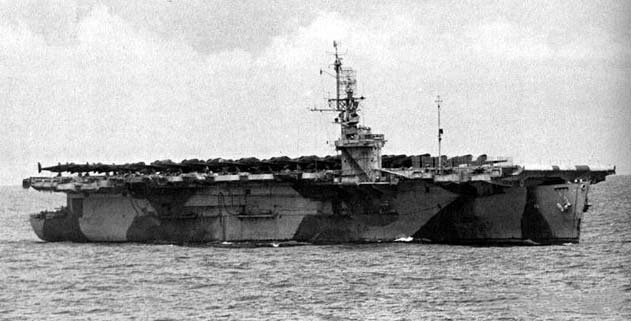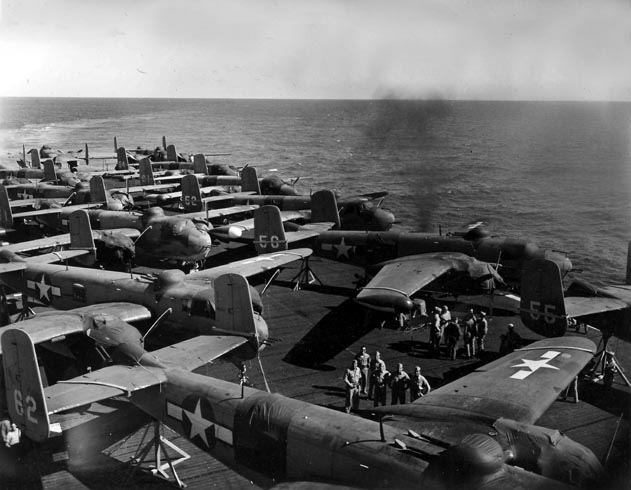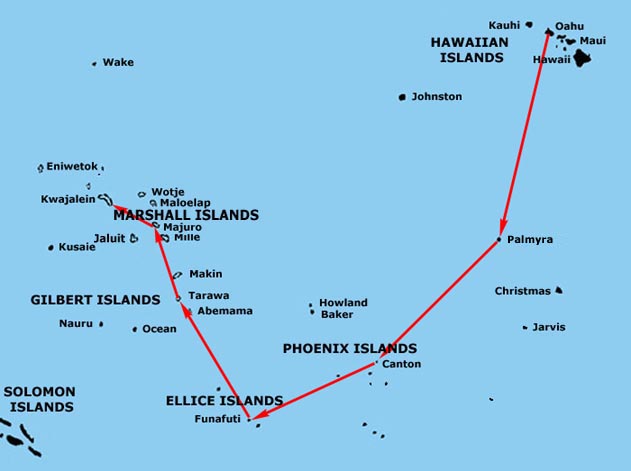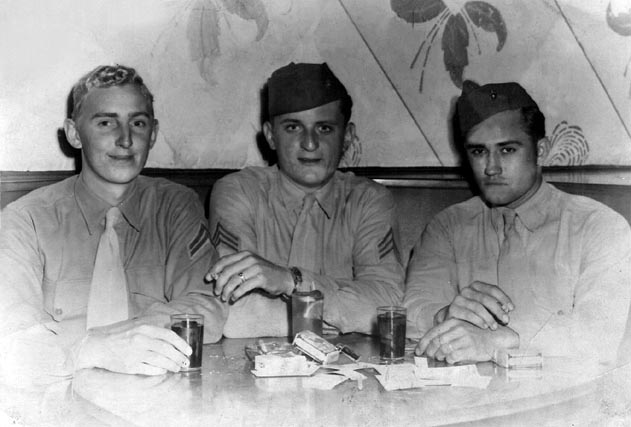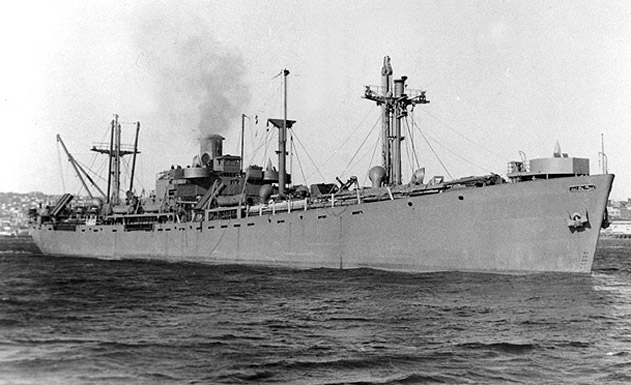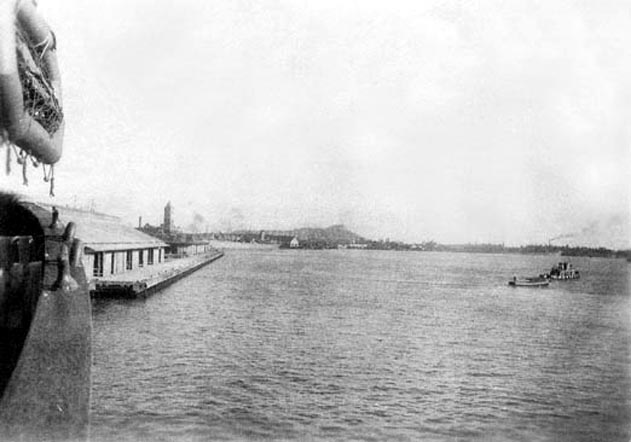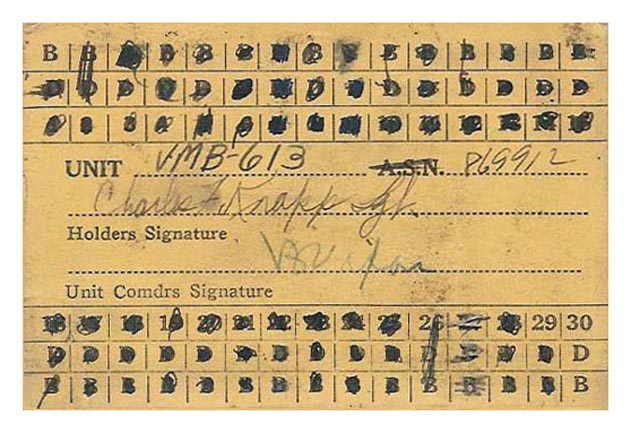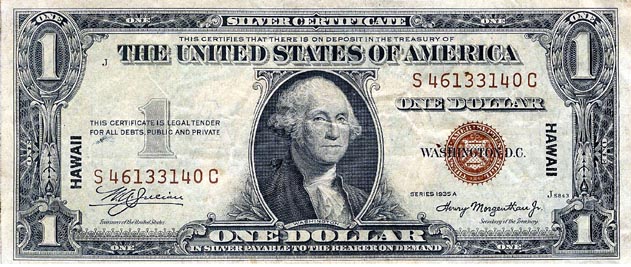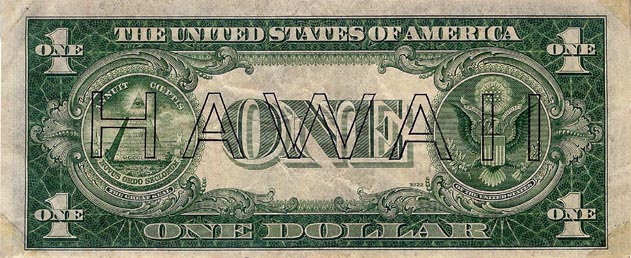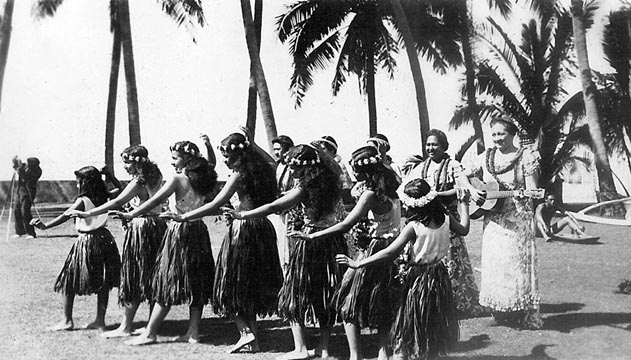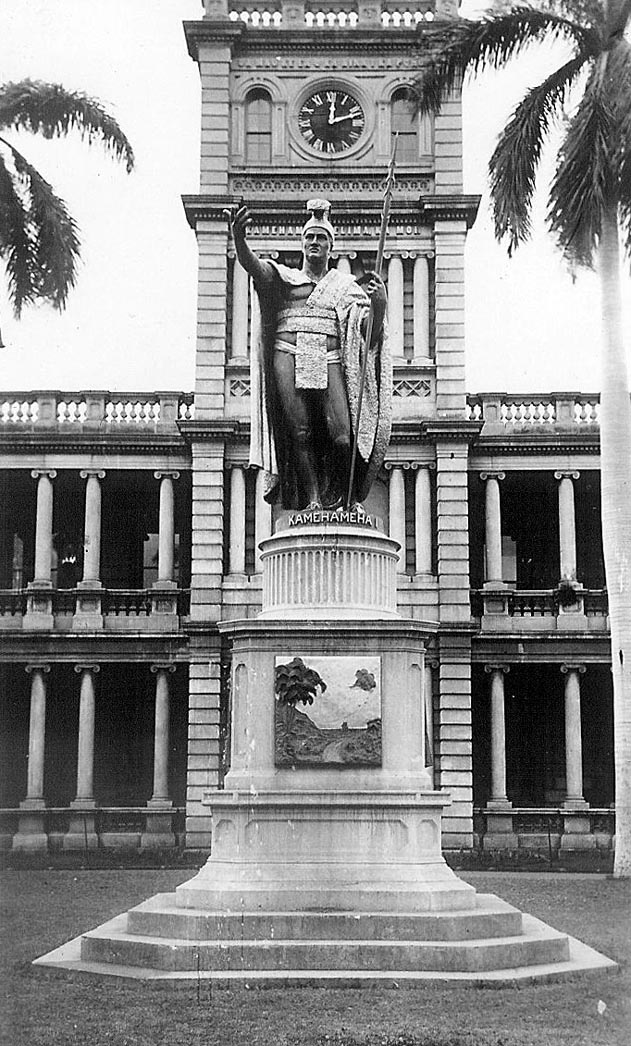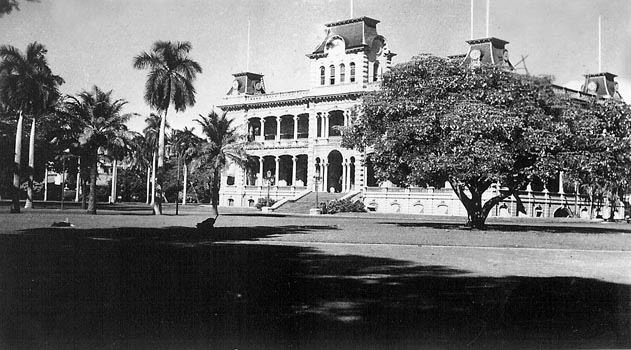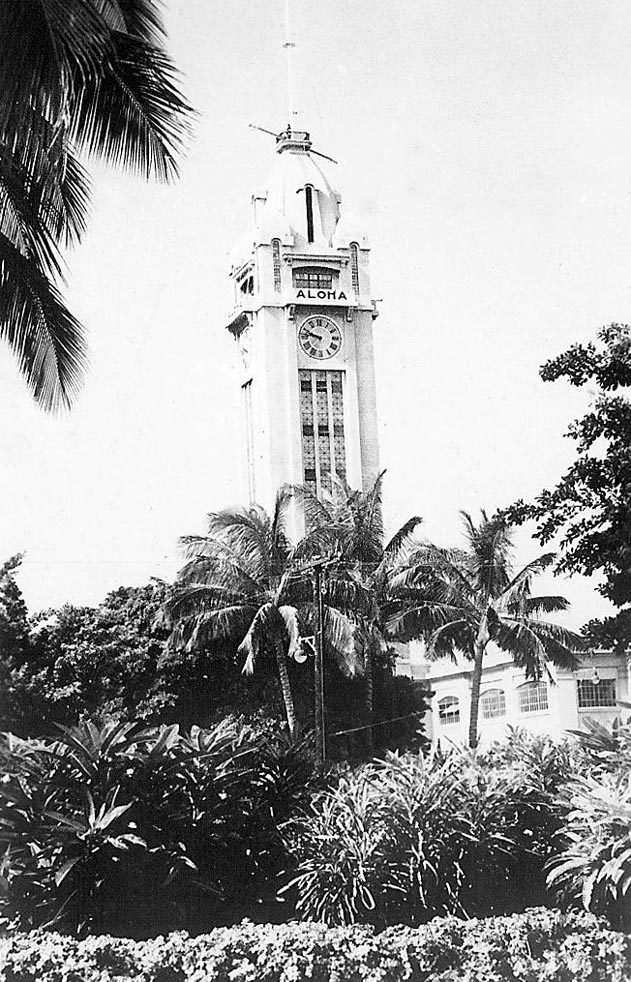|
|
||
|
|
||
|
|
DEPLOYMENT TO THE PACIFIC: PAGE 1 On the morning of October 21, 1944 the squadron began the first leg of their deployment overseas, beginning with the departure of the air echelon. All 15 of the squadron's PBJ-1Hs took off from MCAF Newport, Arkansas, headed for El Paso, Texas. In order to conduct a fuel consumption test during this leg of the flight, each aircraft departed MCAF Newport at five-minute intervals. Upon arrival at El Paso, the aircraft were refueled and departed for Marine Corps Air Station (MCAS) El Centro, California, and from there to Naval Air Station (NAS) North Island, California, arriving on the 22nd of October. In the late afternoon of October 21st the train that was to carry the ground echelon finally arrived. The squadron formed, marched to, and boarded the train with the well wishes of the people of Newport. The train then proceeded to Marine Corps Air Depot (MCAD) Miramar, California, arriving after a long and monotonous trip in the late evening of October 25th. While the ground echelon was en-route, the air echelon had made some last minute changes to the aircraft at NAS North Island. The aircraft were then loaded onto the escort carrier USS Tulagi (CVE-72) for shipment overseas. Following a few changes in their personnel roster, the air echelon enjoyed one last liberty in Los Angeles, then boarded the USS Tulagi and departed for Pearl Harbor, Hawaii on October 30th. The crossing to Pearl Harbor the was filled with excitement as the USS Tulagi, sailing without escort, took action to evade the Japanese submarine I-12 that had been reported in the area. Arriving at Pearl Harbor, the aircraft were unloaded at Ford Island, then flown to MCAS Ewa. After a few days the aircraft were flown to Naval Air Station (NAS) Barber's Point where rocket rails were installed underneath each wing. While the pilots awaited the arrival of the ground echelon they, spent time in ground school, a land and water survival course, and sight-seeing. The ground echelon remained at MCAD Miramar for three weeks under the command of Captain Corwin R. Mocine, the squadron intelligence officer. This time was spent in classes, securing and marking all equipment, and enjoying liberty in Los Angeles and San Diego. On the morning of November 22, 1944 the ground echelon, some 500 strong, departed San Diego for Pearl Harbor aboard the U.S. Army Transport (USAT) George W. Julian. The first few days at sea some problems were encountered. First, a violent storm pitched and tossed the ship. Next the Marines learned that, in the tradition of the U.S. Army, they would only receive two meals per day. This problem was solved upon the insistence of three meals per day by the squadron's officer-in-charge, and the use of the squadron's cooks to assist in the ship's galley. Once the transport had joined the convoy the remainder of the trip proceeded smoothly and time passed quickly. Arriving at Pearl Harbor on Sunday afternoon, December 3rd, some additional changes were made to the air and ground echelons. It was decided that all pilots were to be taken off the USAT Julian in order for them to receive additional training. In their place, all copilots in the air echelon were reassigned to the transport for further movement. While awaiting the arrival of the ground echelon, all pilots in the air echelon attended the rocket firing course at NAS Kaneohe on November 24th. There, after several days of practice, they became proficient in learning to dive their aircraft at exactly 15 degrees and estimate ranges of 1,500, 1,000, and 500 yards. On December 8th, following the arrival of the ground echelon, all pilots received additional training in survival and resisting interrogation, should they be captured. Major Nevils also used this time practicing coordinated attacks with the aircraft's 75mm cannon and 3.5 inch rockets. The results of this practice indicated that the APG-13A gun director was highly accurate, and that attacks would be very effective against enemy shipping. With additional training completed, both the air and ground echelons prepared to depart for their destination in the Pacific—Kwajalein Atoll, Marshall Islands. The air echelon prepared a flight plan that called for the trip to be made using the southern route, from Ewa to Palmyra, Canton, Funafuti, Tarawa, Majuro, and finally, Kwajalein. This would provide the squadron's navigators with much needed experience in over-water navigation. The flight was to be made in three sections, the first being led by Major Nevils, the second by Major Danser, and the third by Captain O'Reilly. On December 10th the movement began with the USAT Julian departing with the squadron's ground echelon for Kwajalein. This same day, Major Nevis' section departed MCAS Ewa with four aircraft, followed by Major Danser's six-plane section the following day. Captain O'Reilly's section, composed of the remaining five aircraft, departed on December 14th. By December 19, 1944, all 15 aircraft had arrived on Kwajalein without serious incident. On Kwajalein, the squadron was assigned to an area that consisted of 15 wooden building, previously used by an Army Bomber Group. Unfortunately, when this group departed they had completely stripped the buildings of virtually everything including electrical wiring, light bulbs, plumbing and fixtures. Although two heads had been left, these had been closed by the island's doctors. The air echelon, left with little choice, slept on the floors of these buildings, anxiously awaiting the arrival of the ground echelon with all the necessary gear and equipment to make the buildings livable. One of the heads was temporarily re-opened for their use until new ones could be constructed, and they were able to secure permission to eat at the Marine Air Group 15 (MAG-15) mess hall until the arrival of the ground echelon. On December 23, 1944, the ground echelon arrived at Kwajalein and disembarked from the transport. Work on the squadron area began the following day. The priority was to establish the squadron's mess hall since the arrangement to use MAG-15's mess hall was a temporary one. By December 27th, the squadron's mess hall was completed and functional. The following day, work on the squadron's offices was completed and preparations began for flight operations. Work on the remaining area continued until all the men had settled-in and the squadron's area was in order. On December 29, 1944 Lieutenant Colonel Nevils, having just been promoted, received "Secret Operations Plan Order 2-44" from Commander, Task Force 96. This order appointed him commander of the Kwajalein Air Group. As the year ended Lieutenant Colonel Nevils reported that VMB-613 had 72 officers, 467 enlisted men onboard. Marine Bombing Squadron Six-Thirteen was now ready to commence operations.
CALIFORNIA BOUND: On October 21, 1944 VMB-613's air echelon departed Newport in their fifteen PBJs bound for San Diego, California. Their route took them there with fuel stops in El Paso, Texas and El Centro, California. Image: Arthur H. Navarre Collection (Courtesy of Diane Hindy)
USS TULAGI: Fifteen PBJ-1Hs of Marine Bombing Squadron Six-Thirteen crowd the flight deck of the USS Tulagi (CVE-72) as the squadron’s air echelon departs San Diego for Pearl Harbor in October 1944. En-route to Hawaii, the USS Tulagi traveled without escort and maintained a zigzag course due to the threat of Japanese submarines. Photograph: U.S. Navy Historical Archives
AIRCRAFT ABOARD THE USS TULAGI: Fifteen VMB-613 PBJ-1Hs crowd the aft portion of the flight deck of the escort carrier, U.S.S. Tulagi, as the air echelon sails toward Pearl Harbor in November 1944. Note the large identification number on the vertical stabilizers of each aircraft and the tarps covering the Plexiglas and engines. Photograph: U.S. Marine Corps, David Snider Collection (Courtesy of the Manning Brothers)
ROUTE OF AIR ECHELON: The air echelon of VMB-613 flew from Oahu to Kwajalein via Palmyra, Canton, Funafuti, Tarawa, and Majuro, This route provided the squadron's navigators with needed experience in over-water navigation.
LAST LIBERTY: Staff Sergeant Robert W. Shock, Staff Sergeant Paul J. Yanacek and Staff Sergeant Herbert R. Folk (L-R) enjoy their last liberty in San Diego, California prior to VMB-613's heading to the Central Pacific in late-November, 1944. Photograph: Marine Bombing Squadron Six-Thirteen (Courtesy of Paul J. Yanacek)
USAT GEORGE W. JULIAN: Marine Bombing Squadron Six-Thirteen’s ground echelon was transported from San Diego to Hawaii on a Liberty Ship, the U.S. Army Transport (USAT) George W. Julian. The trip to Pearl Harbor took 12 days, with the ground echelon arriving on Sunday, December 3, 1944. Photograph: Smithsonian Institution Historical Division
DEPARTING FOR KWAJALEIN: Aboard the USAT George W. Julian, VMB-613's ground echelon departs Pearl Harbor in December 1944 bound for Kwajalein. Diamond Head can be seen in the background. Unlike the air echelon who were able to visit sites on Oahu, the ground echelon was restricted to the ship and not permitted to go ashore. Photograph: Marine Bombing Squadron Six-Thirteen (Courtesy of Sanford Inman)
MEAL CARD: This Meal Card was issued to Staff Sergeant Charles F. Knapp upon embarkation aboard the USAT George W. Julian in 1944. The signature of the authorizing officer is that of VMB-613's engineering officer, First Lieutenant Van B. Nixon. A card like this was required by each member of the squadron in order to account for the meals each Marine was served. Photograph: Marine Bombing Squadron Six-Thirteen (Courtesy of Charles F. Knapp)
HAWAIIAN TERRITORY CURRENCY: A one-dollar bill, known as a "Hawaii Overprint." was stamped with the word "HAWAII" beginning in 1942. This was done during the war years so it could be easily recognized and rendered void in the event the Japanese invaded the Hawaiian Islands and captured the currency. Image: Arthur H. Navarre Collection (Courtesy of Diane Hindy)
HAWAIIAN TERRITORY CURRENCY: The reverse side of the above one-dollar bill is also stamped with the word "HAWAII." Money stamped in this manner was the only currency permitted in the Hawaiian Territory during the war until October of 1944. Image: Arthur H. Navarre Collection (Courtesy of Diane Hindy)
HULA DANCERS: Native Hawaii girls performing the hula dance, accompanied by guitar music. Photograph: U.S. Marine Corps, Arthur H. Navarre Collection (Courtesy of Diane Hindy)
GREAT HAWAIIAN KING: Located in Honolulu, this statue honors Hawaii's great king, Kamehameha I. It is located directly in front of the Ali'iolani Hale. Photograph: U.S. Marine Corps, Arthur H. Navarre Collection (Courtesy of Diane Hindy)
'IOLANI PALACE: The 'Iolani Palace is a restored historic building in downtown Honolulu that was once served as the home of Hawaiian royalty. Photograph: U.S. Marine Corps, Arthur H. Navarre Collection (Courtesy of Diane Hindy)
ALOHA TOWER: Constructed in 1926, this landmark, at 185-feet, was the tallest building in Honolulu during the Second World War. Photograph: U.S. Marine Corps, Arthur H. Navarre Collection (Courtesy of Diane Hindy) |
|
|
Copyright © 2008 Marine Bombing Squadron Six-Thirteen Association. All Rights Reserved. |
||
